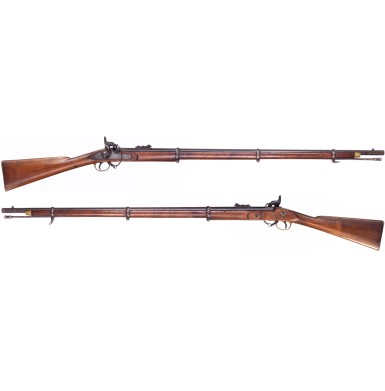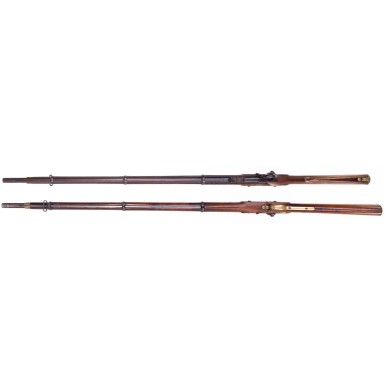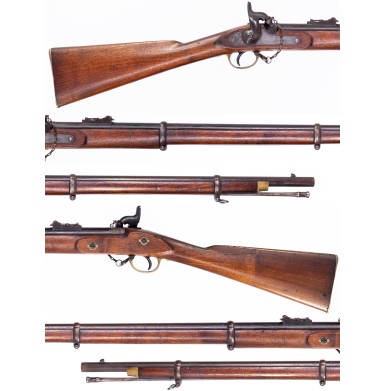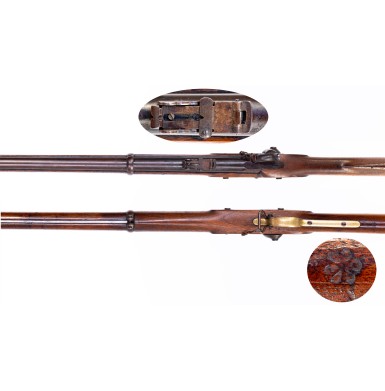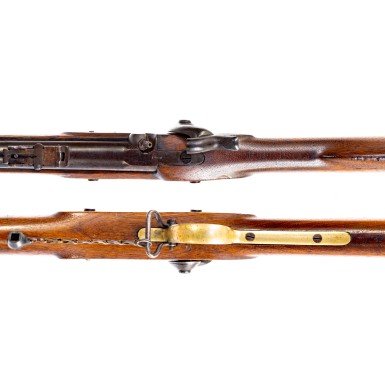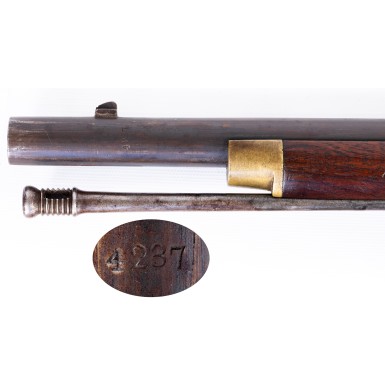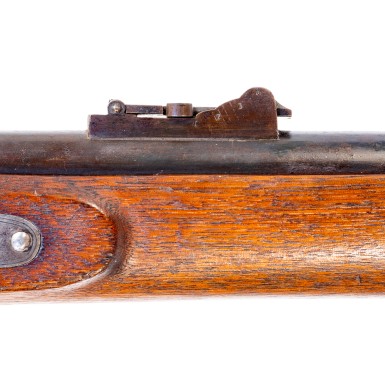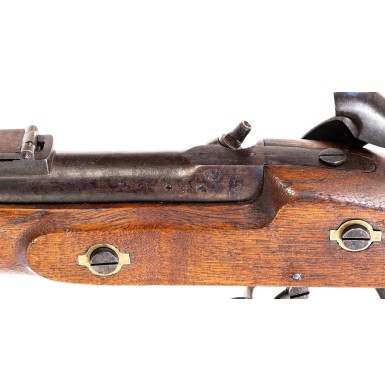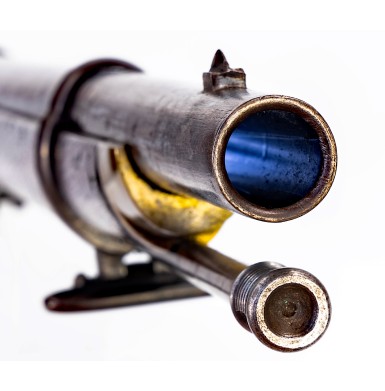Rare & Fine JP Moore "M Rifle" Enfield Rifle Musket
- Product Code: FLA-4068
- Availability: In Stock
-
$2,995.00
The “M Rifles”, an American variant of the British Pattern 1853 Enfield Rifle and Rifle Musket have long been an enigmatic mystery to American arms collectors. So confused was the story that at one time, these Enfields were categorized as Confederate-made arms, and it took decades after the proof that they were not Confederate arms for the story to finally die off. Correspondence and contracts clearly prove that these guns were at the very least sold by J.P. Moore’s Sons of New York City, but their exact origin and production is still shrouded in mystery and there are often more theories than proof when it comes to discussing these arms.
The company that bore John P Moore’s name was established by him in New York in 1823 at 302 Broadway. Moore was a gunsmith who performed repairs, built guns and sold them as well. Like many American gunmakers during the second quarter of the 19th century, Moore was likely much more of a gun assembler than a craftsman who made every part of the gun. Most makers during this period relied upon commercial locks and barrels, often imported from England or Belgium, as well as commercially available brass and iron furniture. What the maker did was assemble guns from these available parts, being more like gun stockers than the classic image of the gunsmith who made each and every lock, stock and barrel. In 1838 John moved the business to 204 Broadway, where it would remain for more than two decades. In 1863 the firm would relocate to 208 Broadway, where it would remain until it went out of business circa 1887. In 1855 John’s sons George G and Henry T Moore joined the firm, and it became John P Moore & Sons. In 1860 the company was officially reorganized as John P Moore’s Sons, and the direction of the company shifted to more retailing and importing of arms than their production. At that time, inexpensive single- and double-barrel percussion shotguns were readily available for import from England and Belgium and American retailers often sold them with a retailer mark applied that would make many think they were the makers of the guns. Moore marked import shotguns survive to this day, as do at least a couple of southern retailer-marked shotguns that also bear Moore markings. This indicates that they were large enough importers to be able to do wholesale business with smaller gun retailers in the south. The Moore’s also became distributors and retailers for Colt revolvers and were the New York agent for Colt’s Patent Firearms Manufacturing Company. This close association with Colt may be an integral part in figuring out exactly what the true source for the Moore Enfields really was.
With the outbreak of the American Civil War, John P. Moore’s Sons, like so many people in the firearms business, sought to sell small arms to the US Government. Records indicate that the firm sold some 22,000 “Long Enfield Rifles”to the US Government, which were imported from Great Britain. It is possible that the connections necessary to obtain such a large number of Pattern 1853 Enfield Rifle Muskets at a time when every major and minor arms broker in the north and south was trying to acquire them in England may have been made by Colt, who the Moore’s acted as agents for in New York.
The Moore’s offered to sell both long and short American-made Enfields (rifle muskets and rifles) to the US Ordnance Department and received a positive response. During 1862 the company delivered 999 of their “M Rifle” short Enfield pattern rifles between January and March and 1,280 “M Rifle” long Enfield pattern rifle muskets between June and September. The guns must have been of good quality because the majority of the Long Enfields were paid for at the rate of $15 each with 440 of them accepted at the rate of $16.125 each. The true origin and maker of these guns, however, remains somewhat unclear.
It has been suggested by some that the guns were simply imported arms, made in Birmingham or Liège and sold to the Government. However, examination of most extant examples does not bear this out. The guns did, however, tend to use a variety of imported parts in their construction, most notably barrels from both Liège and Birmingham. Additionally, the two other makers of “American Enfields”, Robbins & Lawrence of Windsor, VT and Orison Blunt of New York are also connected to the Moore Enfields. Robbins & Lawrence had produced Type II British Pattern 1853 Enfield Rifle Muskets during the Crimean War for the British Government. The quick end to the war and the cancellation of the British contract had led to that firm’s bankruptcy. At an asset auction for the defunct firm, the Whitney Arms Company acquired many Enfield pattern parts, both finish and unfinished, as well as machinery to make Enfield parts. Surviving correspondence indicates that the Moore’s contacted Whitney on a number of occasions in an attempt to acquire various Enfield pattern parts. Some of the parts were apparently obtained, but in 1863 it appears that Whitney had used up most of the parts the Moore’s were seeking, in the production of his own series of Enfield variant arms.
The firm of Orison Blunt of New York City had also offered to provide Enfield pattern arms to the US Government. They contracted to deliver 20,000 American-made Long Enfields on September 10, 1861, at the rate of $18 each. The Ordnance Department agreed to the proposal but stipulated that the guns would have to pass government inspection. Deliveries were to begin within 60 days and the guns were to be delivered in lots of 500 or 1,000 per month until the contract was completed. By February of 1862 no deliveries had been made, and the contract was voided for failure to deliver the arms. The investigation by the Holt-Owens Congressional Commission in March of 1862 endorsed the contract cancellation, however, they did offer to accept as many guns as Blunt could deliver, up to 3,000, by July 1, 1862. Blunt managed to put together a single lot of 500 arms to deliver but they were rejected out of hand without inspection because the barrels had not been proofed by the Ordnance Department, who required they be proofed before they were rifled. As the guns were completed, and rifled, they could not be proofed per the requirements. As a result, they were not accepted. It is believed that they were then sold on the open market, likely to state buyers. The connection between Blunt and Moore is based upon a surviving Blunt marked Enfield which has remnants of Moore’s “Eagle over Shield” mark at the tail of the lock, suggesting that Blunt may have obtained some of the parts for his guns from Moore.
Moller notes that some surviving Moore Enfields have Belgian made barrels and hypothesizes that these may have been obtained from Colt who he notes had ordered some 10,000 barrels in Liège to use in the production of his Special Model 1861 Rifle Muskets. As the Ordnance Department would not accept foreign made barrels in the Colt contract guns, it has been suggested that Moore may have acquired some of them. It is documented that Colt obtained a similar number of barrels in Birmingham, England to use in his rifle musket production and then found that they would not be accepted. These are the previously enigmatic “Diamond-C” marked English barrels with somewhat larger breech areas that most Enfield barrels and which were made in both 39” and 40” lengths. Those barrels were subsequently sold on the open market in Birmingham where they were acquired by a number of Birmingham makers and used to produce Enfield rifle muskets for both the North and the South. I have not seen a Moore Enfield with a Liège-marked barrel, but I have seen plenty with Birmingham-made barrels. Additionally, I have not seen any “Diamond-C” marked British barrels used to produce Moore Enfields.
The most reasonable explanation for the Moore delivered guns is that they were assembled in the United States, probably by Moore or their contracted jobbers, using a combination of imported and locally sourced parts. The guns are assembled with Enfield pattern locks that are marked with the date forward of the hammer, typically 1862, 1863 or sometime 1864 and with a spread-winged eagle over a shield with an “M” in it, at the tail of the lock plate. At least two variations of this mark have been seen. Unless Moore acquired the machinery to produce Enfield pattern locks, there were only two practical sources for them to acquire locks in quantity; either from Whitney from the stocks or Robbins & Lawrence produced locks or from England. As the lock markings would have to be struck after they were forged but before they were casehardened, it is possible that the different markings were the result of the locks coming from different sources. My theory is that some of the locks were assembled by Moore using parts and plates obtained from Whitney, while the other locks were acquired in their finished state, and already marked, from England. As noted most examined examples have Birmingham commercial proofs on their breeches, and Birmingham maker marks underneath. The Moore delivered guns will also be found with a script ETU mark on the left side of the breech. The Moore Enfields are also serial numbered on the barrel, usually on the left side, near the muzzle. In almost all cases the stocks are of American Black Walnut, indicating that the guns were at least assembled in America and were not delivered as complete guns. The rear sights are of the basic Enfield pattern, but the elevating leaf is an improvement on the English design and has a screw for tension, allowing for much more accurate and repeatable adjustment than the friction only system used on the English-made guns. The balance of the furniture is of Enfield pattern and most of it could have been obtained from either English sources, made by Moore’s jobbers, or obtained from Whitney. The one part that Whitney could not have provided were the barrel bands. The Robbins & Lawrence contract was for the Type II Enfield, which had solid barrel bands secured by springs. The Moore delivered guns utilize the Palmer pattern screw clamping bands that were used on the Type I and Type III Enfields. Moller mentions the existence of Moore Enfields with British inspection marks on the barrel bands and suggests these were Robbins & Lawrence parts left over and sold by Whitney. This is not possible because the Robbins & Lawrence bands were not of the pattern Moore used. Any British inspections, particularly military inspections, found on Moore Enfield barrel bands would suggest that the bands are either 1) and incorrect replacements, or 2) that some parts that had been viewed by British inspectors were sold by Birmingham contractors to Moore before they were used to make complete guns in England.
As all of the Moore contract Enfield Rifle Muskets that were purchased by the US Ordnance Department were delivered between June 30 and September 25 of 1862, any guns with lock dates of 1863 or 1864 were produced for sale on the open market. It is not clear who acquired them, but it is generally believed that they were purchased by northeastern states like New York for the use of their locally raised regiments and militias. As the guns were for all practical purposes indistinguishable from English Enfields to the untrained eye, they were likely never inventoried separately from other Enfields and raises the possibility that some were delivered to the US Government in the lots of imported Enfield Rifle Muskets, and it is likely that no one was the wiser.
Offered here is a VERY FINE condition example of a fairly scarce J.P. Moore’s Sons Pattern 1853 Enfield “M Rifle” Musket. The gun remains in wonderfully crisp condition and retains much of the original blue on the barrel. Other than the markings, the gun would easily be mistaken for a standard English-made Pattern 1853 Enfield Rifle Musket. The lock is crisply and clearly dated 1863 forward of the hammer and is deeply struck with the Moore trademark of a {Spread-Winged Eagle} over the {Shield of Columbia} with an “M” in the shield and 12 dots that represent “stars”. The other variant of this mark that is known has 18 “stars” rather than 12. The interior of the lock is marked with a large N near the mainspring boss stud, in the location where an English lock maker would normally put their name. The lock is also marked with the mating mark 84, stamped upside down. This same number is also found stamped under the barrel, along with a large N like that in the lock. The exterior of the 39” English-made barrel shows the standard Birmingham commercial Provisional Proof, View and Definitive Proof marks, as well as a pair of “25” gauge marks, indicating .577 caliber. The breech also has the script ETU mark found on Moore delivered Enfields, which was likely an Moore applied inspection or proof mark. Under the barrel is the name CHAS REEVES, the mark of Birmingham gunmaker Charles Reeves. Reeves worked circa 1854-1885 and during the American Civil War was located at 29 Charlotte Street Parade. At the time he was listed as a “Gun, Pistol & Rifle Maker and Gun Barrel Maker” and his location was known as the “Toledo Works”. Like the typical Moore delivered Enfield, this example is serial numbered on the barrel, in this case on the left side near the muzzle. The serial number is 4237, indicating that the Moores likely made at least five thousand Enfields and possibly more. The only other exterior mark is a stamp behind the triggerguard that is a flower with six petals. The meaning of this mark is unknown.
As noted, the gun remains in VERY FINE condition and is very crisp. The barrel retains about 60%+ thinning and streaky blue on the top of the barrel and more like 80%+ underneath where it has been protected by the stock. The lock has a dull grayish patina, but it is worth noting that the Moore guns are not known for having vibrant case colored mottling like most high condition English Enfield locks do. The metal is almost entirely smooth throughout with some freckles of minor surface oxidation here and there, some minor oxidation in the breech and bolster area and some lightly scattered pinpricking in that region as well. The brass furniture has a medium golden patina and is very attractive. The lock remains in fine mechanical condition and functions very crisply. The original rear sight is in place and intact, remaining fully functional. The sight base and sight ladder have the matching assembly marking 72. The original musket pattern front sight and socket bayonet lug is in place on top of the barrel, near the muzzle. The Palmer pattern clamping barrel bands all retain the little doughnut shaped screw protectors, small parts that are often missing. Both sling swivels are present and intact as well. An original snap cap is attached to the lower sling swivel, it is complete with the exception of some loss to the leather pad on top. An original full-length jag head ramrod, complete with good threads on the end, is present in the channel under the barrel. The bore of the gun is in VERY FINEcondition as well. It is mostly bright with some moderate oxidation in the last few inches near the muzzle and retains fine, crisp rifling. The stock of the gun full-length and free of any breaks, cracks or repairs. The wood is very crisp with strong edges and a feathery texture over much of the wood. The wood shows some scattered bumps, dings and mars, but shows absolutely no abuse and the condition of the wood matches the fine condition of the metal very nicely.
Overall, this is very crisp and fine condition example of a fairly scarce J.P. Moore’s Sons Pattern 1853 Enfield “M” Rifle Musket. The gun is 100% complete and correct in every way and is extremely attractive. This is one of the three “American Enfields” and would be at home displayed with a Robbins & Lawrence “Windsor” Enfield and an Orison Blunt Enfield. These scarce guns are an interesting example of how some Northern companies sought to capitalize on the military needs of the US Government during the Civil War by delivering arms they essentially “assembled” rather than manufactured. These guns are still not fully understood by arms historians and further research may be able to fully flesh out the story of these guns. This is fine, crisp gun that should please even the most discriminating of collectors and is one that I am sure you will be proud to add to your collection.
Tags: Rare, Fine, JP, Moore, M, Rifle, Enfield, Rifle, Musket


